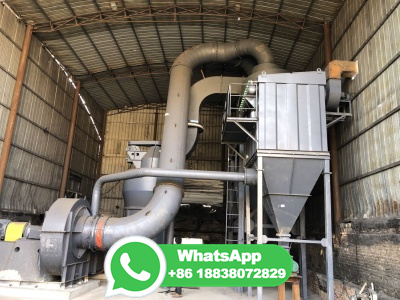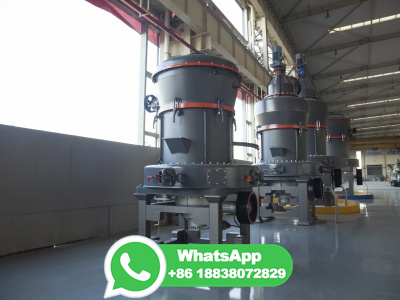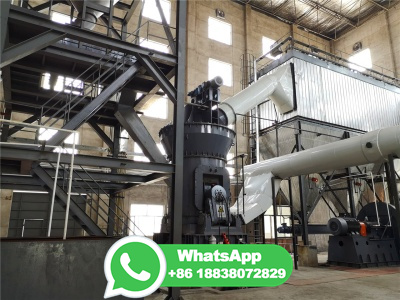
WEBJan 22, 2021 · In the whole process of cement production, the electricity consumption of a raw material mill accounts for about 24% of the total. Based on the statistics of the electricity consumption of the raw material mill system of 1005 production lines in China between 2014 and 2019, it is found that the average electricity consumption of the raw .
WhatsApp: +86 18203695377
WEBFeb 23, 2016 · Cement is made by heating limestone and other materials to form clinker, which is then ground with gypsum. The main steps are mining raw materials, crushing, grinding to a raw meal, pyroprocessing to form clinker, and final grinding of clinker to cement. Key equipment includes raw mills, kilns, preheaters, and ball mills.
WhatsApp: +86 18203695377
WEBFeb 25, 2021 · Steel balls are one of the most widely used grinding media in cement ball mills, their diameters can range from 20mm to 120mm according to different grinding requirements. In a cement ball mill, generally, φ50–100mm steel balls are used in the coarse grinding chamber, φ20–50mm steel balls are used in the fine grinding chamber. 2.
WhatsApp: +86 18203695377
WEBSep 10, 2018 · This study focused on ex ergy utilization, exergy balance and irreversibility for a raw mill in the cement. industry using the real plant data and li terature data. Exergy eff iciency of the raw ...
WhatsApp: +86 18203695377
WEBThe production of cement typically involves milling of grounded limestone, clay, and sands. Raw materials are milled into a fine powder, which is then blended and heated to form cement. One type of machine used in this process is a ball mill.
WhatsApp: +86 18203695377
WEBAug 21, 2023 · We are operating a mill with lowest power, KWh/MT with 10 per cent on 90 micron for raw material grinding. • CPI LNVT Ball Mill: CPI LNVT is a renowned manufacturer of grinding equipment for the cement industry. Their ball mills are widely used for grinding cement clinker, gypsum and other materials into a fine powder.
WhatsApp: +86 18203695377
WEBMay 12, 2023 · The main equipment for grinding construction materials are balltube mills, which are actively used in industry and are constantly being improved. The main issue of improvement is to reduce the power consumption of a balltube mill with crosslongitudinal movement of the load. A comparative analysis and the possibility of using the known ...
WhatsApp: +86 18203695377
WEBFeb 1, 2020 · The results demonstrated that the VRM unit consumes around 81% ( kWh/t of raw materials), and 36% ( kWh/t of raw materials) more energy to grind raw material than the IBAT unit and domestic ...
WhatsApp: +86 18203695377
WEBJan 26, 2024 · In cement manufacturing industry, the grinding process is one of the most energy consuming processes. ... Generally, ball mills are utilized for grinding the raw material into finished product (cement) in grinding unit of cement plants. As the cement manufacturing is the continuous process, it is necessary to properly maintain the ball .
WhatsApp: +86 18203695377
WEBclick here to Download the Most Important 13 Books in Cement Industry PROCESS TRAINING for operators of Vertical RAW Mills . Heating of mill and grinding plant. In fact there are three processes going on in the MPS mill namely grinding, drying and clas sifying, and only when all three processes are working well the operation is smooth.
WhatsApp: +86 18203695377
WEB95200. 3600. 750. Don't hesitate to reach out to us for a quote if you are interested in cement grinding business! Questions and suggestions are also welcome! Purchase cement mill for your cement plant from AGICO one of the most renowned cement equipment manufacturers in China.
WhatsApp: +86 18203695377
WEBCement Industry: Ball mills are extensively used in the cement industry for grinding raw materials, clinker, and additives to produce cement. The ability to finely grind materials and control the grinding process makes ball mills crucial equipment in cement manufacturing.
WhatsApp: +86 18203695377
WEBMay 1, 2011 · Typically, an electrical motor of the ball mill uses about 14–15 kWh/tonne of raw mix. On the other hand, a VRM motor uses about 7–8 kWh/tonne. On an overall basis, a VRM consumes about 20% lower specific energy than a conventional closed circuit ball mill. A VRM is widely used for raw material and coal grinding in the cement industry. .
WhatsApp: +86 18203695377
WEBOverview of size reduction of raw materials of the cement industry. ... Ball mills are horizontal rotating cylindrical or conical steel chambers, approximately one third to half full of steel, alloy steel or iron balls, like that shown in Fig. A–C, or flint stones. The size reduction is accomplished by the impact of these balls on the ...
WhatsApp: +86 18203695377
WEBJun 1, 2012 · Ball mills can grind a wide range of materials, including metals, ceramics, and polymers, and can operate on a variety of scales, from laboratory to industrial (Monov et al. 2013). ...
WhatsApp: +86 18203695377
WEBMar 7, 2024 · Dry ball milling has extensive appliion in mineral processing, where it serves various purposes in refining and processing raw materials. This technique involves grinding materials in a ball mill without the addition of any liquid, resulting in finely ground powders with controlled particle sizes and distributions.
WhatsApp: +86 18203695377
WEBA raw mill is the equipment used to grind raw materials into "rawmix" during the manufacture of cement. ... the early cement industry used the "wet process", in which the raw materials are ground together with water, to produce a slurry, containing 20–50% water. ... Ball mills are rather inefficient, and typically require 10–20 kW·h of ...
WhatsApp: +86 18203695377
WEBJan 23, 2024 · The cement mill is a crucial equipment in cement production, operating through key steps including feeding, grinding, separation, and discharge. Initially, raw materials such as clinker and auxiliary materials are conveyed to the cement grinding mill through a feeding system.
WhatsApp: +86 18203695377
WEBRaw mill: The raw mill will be operate with a much coarser ball charge than the cement mill mainly because of the bigger slot sizes of the partition wall. The transition zone consists of 50 mm and 60 mm balls. The basis is a 50 mm ball size for .
WhatsApp: +86 18203695377
WEBA 10 MW cement mill, output 270 tonnes per hour. A cement mill (or finish mill in North American usage [1]) is the equipment used to grind the hard, nodular clinker from the cement kiln into the fine grey powder that is cement. Most cement is currently ground in ball mills and also vertical roller mills which are more effective than ball mills.
WhatsApp: +86 18203695377
WEBConclusion. In conclusion, the appliion of vertical roller mill technology in the cement industry has revolutionized the way cement is produced. VRMs are more energyefficient, ecofriendly, and produce a more consistent product compared to traditional grinding mills. They are also more suitable for use in urban areas due to their lower ...
WhatsApp: +86 18203695377
WEBApr 25, 2016 · Article [8] has monitored the vibrations of mill engines in the cement industry, depending on the (loading) speed of the balls, the moisture content and the size of the raw material for loading ...
WhatsApp: +86 18203695377
WEBThe raw meal preparation process of the cement industry includes four links: mining, prehomogenization, grinding, and homogenization, which form the homogenization chain of raw meal preparation. Raw meal homogenization is the most important process link of the four, accounting for 40% of the homogenization task.
WhatsApp: +86 18203695377